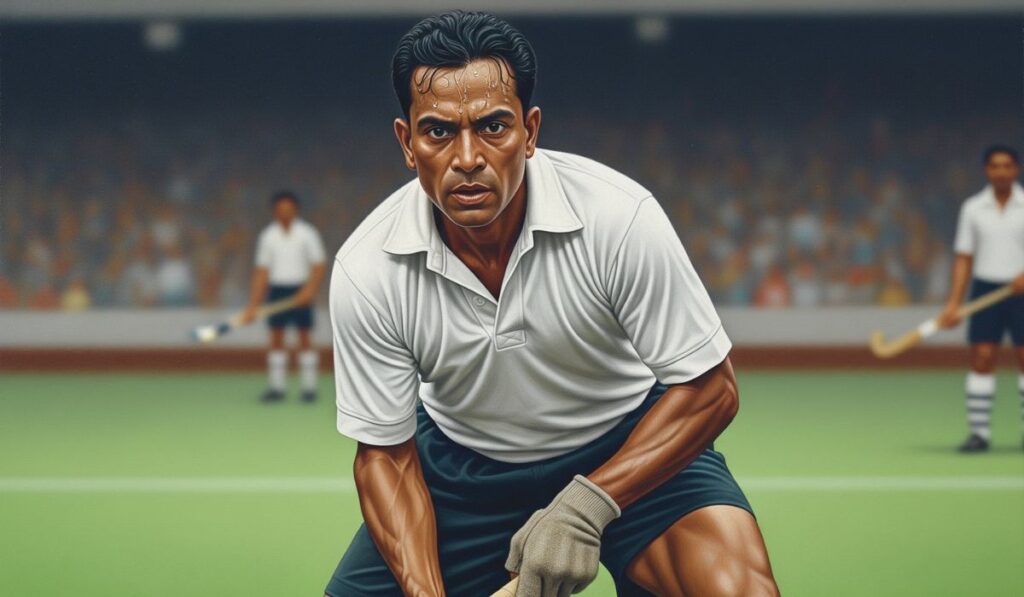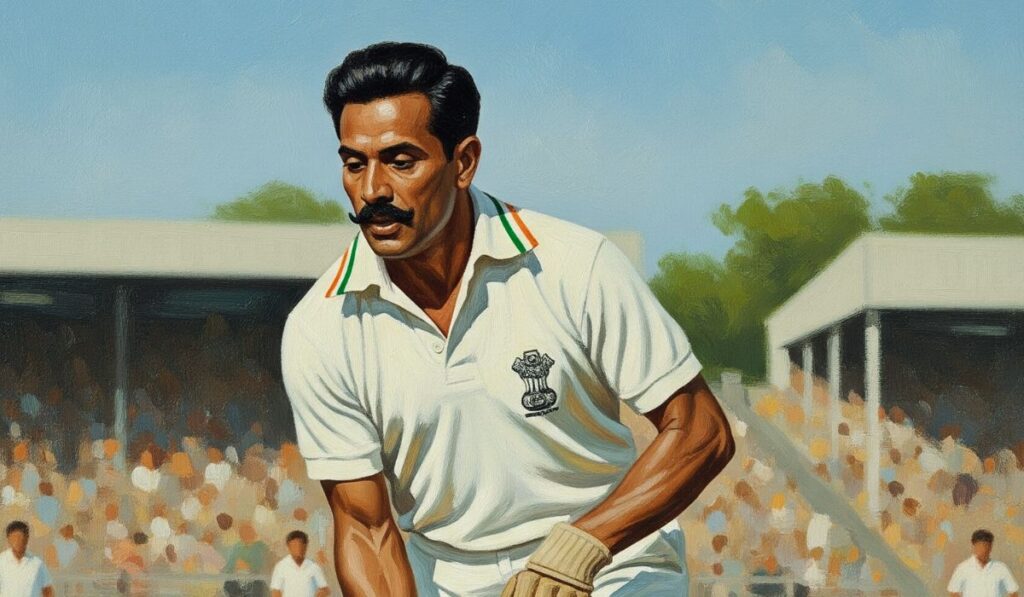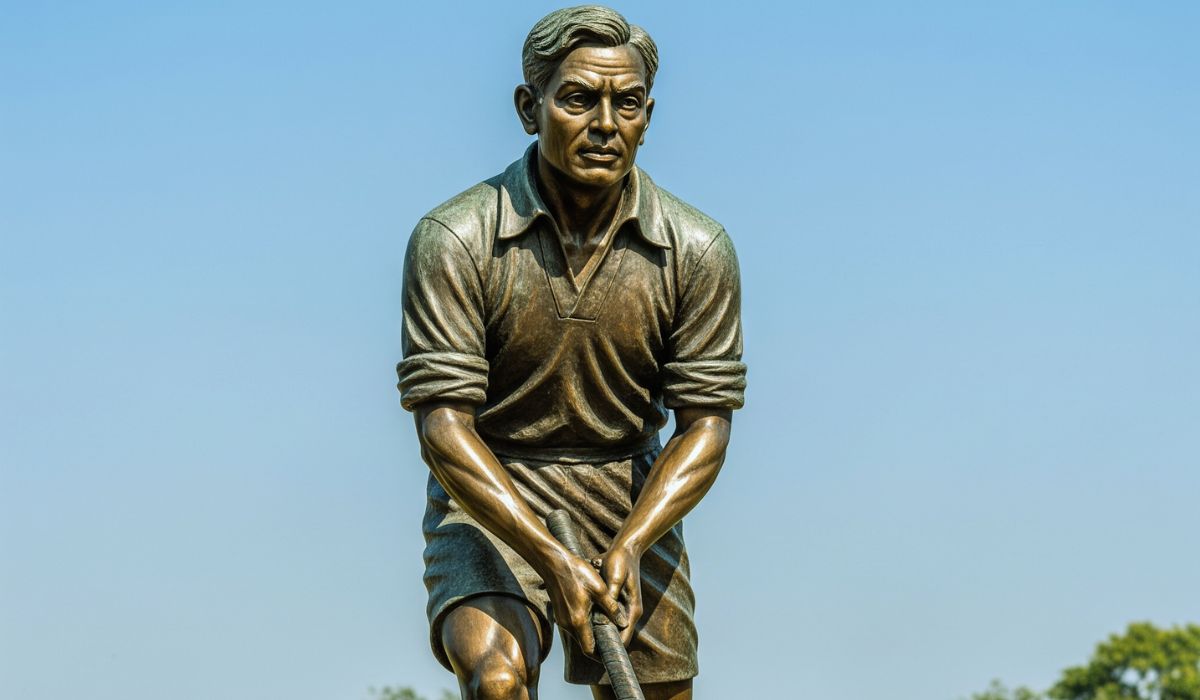“Unmatched Wizardry and Lingering Shadows: Discover the True Story Behind the Legendary Hockey Wizard”
A Legend Carved Out of Moonlit Fields
He was not born into fame—just a boy in Allahabad, India. Yet Major Dhyan Chand Who Was Known as the Hockey Wizard transformed into what the world remembers today as the hockey wizard. While others trained by daylight, he honed his mystical dribbling skills under moonlit skies during his early army days. That quiet, nocturnal practice became the forge for one of the most magical careers ever witnessed.
When Grace Became a Weapon
Dhyan Chand Who Was Known as the Hockey Wizard wasn’t just an athlete; he was an epitome of fluid motion. His dribbling resembled poetry—no fuss, no force. The ball seemed to stick to his stick, even as he weaved through defenders. Fans often whispered that watching him play felt like watching a conductor orchestrate the game, as if players moved at his silent command.
Glory in Golden Medals—and Heavy Expectations
Winning three Olympic golds in 1928, 1932, and 1936 fueled his legend. Yet each triumph amplified the weight on his shoulders—a burden he silently shouldered. Being called the hockey wizard brought both adoration and expectation. That glare of legacy sometimes pressed harder than any opponent’s tackle.
The Dragons of Disability: When Magic Isn’t Enough
Even wizards stumble. Later in his career, Who Was Known as the Hockey Wizard Dhyan Chand faced setbacks—missed goals, fading reflexes, and dwindling fitness. The press that once praised him began to question. The public whispered doubt. The painful realization: even magic has limits when the body ages.
Why the World Still Whispers ‘Hockey Wizard’
Even decades after his retirement, Chand’s name still carries enchantment Who Was Known as the Hockey Wizard. Every dribble, every goal, every golden tackle is studied and celebrated—not just for skill but for the artistry behind it. That enduring reverence is why the label “hockey wizard” still conjures awe.

A Debt Carved in 570 Goals
Chand Who Was Known as the Hockey Wizard scored 570 goals in just 185 international matches between 1926 and 1949—an unheard-of rate in any era. That figure isn’t just a statistic—it’s a testament to relentless hunger and unshakable mastery. A wizard’s output, undeniable.
The Shadow of Neglect After the Spotlight Fades
It’s tragic but true: after his career ended, even Chand faded into relative obscurity. Despite having an award named after him and his birthday celebrated as National Sports Day in India, younger generations often know little of his legend. It’s a testament to how fame can vanish without deliberate celebration.
Passing the Magic: Peers and Successors
Mohammed Shahid and K. D. Singh Who Was Known as the Hockey Wizard were praised as successors to Chand’s wizardry. Shahid was the “reverse flick king,” dribbling past every defender like a phantom K.D. Singh earned the nickname “Houdini of Hockey” for his own mesmerizing ball control. Yet their magic often lived in Chand’s shadow.
A Gentle Warrior: Sportsmanship in Every Spin
Chand played fiercely, yet he showed deep respect—for foes, fans, and the sport itself. Famous stories tell of him refusing honors from Hitler during the 1936 Berlin Olympics, choosing loyalty to country over lavish offer. That humility made his Who Was Known as the Hockey Wizard even more profound.
The Moments That Sparked National Identity
India’s 8–1 triumph over Germany in 1936 wasn’t just a victory—it was symbolic, poetic, even defiant. As Hitler watched, Chand’s brilliance turned a sports match into a historical statement. His stickwork became the language of resistance and pride.
Beyond Stick Work—An Educator in Disguise
After retirement, Chand took up coaching in the Indian Army and various hockey institutions. He didn’t merely teach skills—he taught composure, vision, and how to feel the game under extreme pressure. Who Was Known as the Hockey Wizard He remained a wizard, even off the field.
A Day That Remembers Magic
29 August is celebrated in India as National Sports Day—Chand’s birthday. The nation not only honors his Olympic medals but also remembers how one man made an entire country dream in color and possibility every time he held a stick.
Postcards of Memory: Chand in Modern Media
Despite countless documentaries and articles, his story remains hauntingly romantic but often underexposed. Films and museums occasionally spotlight him, yet mainstream memory fades. It makes you wonder: can magic truly be preserved when its origin fades?
Lessons on the Field and in Life
Who Was Known as the Hockey Wizard Chand’s life reminds us that transcendence can come from discipline. From late-night passes to gold-medal defeats, his path wasn’t smooth. But his obsession with perfection taught that true magic isn’t natural—it’s earned.
The Wizard’s Longevity: More than a Game
He played through eras—pre-independence, war, transition. Still, his style stayed timeless: simple, deliberate, intuitive. He taught that even as rules and equipment evolve, the heart of wizardry—touch, vision, simplicity—never ages.
The Emotional Price of Perfection
Many stories tell of Chand Who Was Known as the Hockey Wizard returning from matches to long silences, distant families, and unspoken mental fatigue. The weight of being a wizard often isolated him—on foreign fields, on sleepless nights, and in the quiet aftermath of victory.
How the Wizard Survives Through Awards
The highest sporting honour in India, Who Was Known as the Hockey Wizard the Major Dhyan Chand Khel Ratna Award, bears his name. That legacy ensures that every aspiring athlete hears his story—not as ancient myth, but living inspiration.
Why Modern Fans Must Reclaim the Magic
In our era of highlight reels and instant gratification, Chand’s Who Was Known as the Hockey Wizard artistry challenges shallow spectacle. His silence before dominance, his discipline within creativity, his subtle power—these reignite passion for hockey’s deeper rhythms.
Controversy or Reverence? The Duality of a Legend
Some critics argue that we mythologize him too much. Others insist we don’t celebrate him enough. That tension—between fair criticism and heroic reverence—adds emotional complexity to his legend Who Was Known as the Hockey Wizard. The wizard is immortal, but his memory is fragile.
What Made the Magic Last Beyond Mortality
Dhyan Chand Who Was Known as the Hockey Wizard died in 1979. Yet, fifty years later, we still feel the echoes of his dribbling form. The wizard’s legacy lives because every one of his stories held truth. Every goal was real. Every move was deliberate. Every passion genuine.
The Silence Behind the Magic
In today’s age of constant noise, Chand’s Who Was Known as the Hockey Wizard legend stands apart in its quietude. There are no viral clips, no social media glad-handing—just decades of reverence passed from mentor to student. That silence makes his legend feel more intimate. It’s whispered by old friends in clubs, hidden in dusty photo albums, and felt in the pause before a young striker attempts a reverse flick. The wizard lived without spectacle—and that absence still speaks volumes.
The Stillness Before the Spell
Fans who witnessed Chand Who Was Known as the Hockey Wizard play recount a moment of calm before he struck—a lag in time where everything seemed to slow. Defenders would hesitate. Goalkeepers would tense. The crowd would hold its breath. Then he’d glide forward, wrist flick, net shudder. That resonance between anticipation and execution created an emotional chasm, reminding us that wrestling with time is part of real wizardry.
The Role of Night Practice in Forging a Legend
He practiced under the moonlight while others rested, giving his dribbling a spectral edge. The glow cast long shadows that taught him to drift and weave like a phantom. That nocturnal discipline sharpened his spatial awareness—every movement was tuned for clarity in dim light. That refinement translated into daylight dominance. It’s why his opponents often seemed confused even before he even touched the ball.
The Art of Coaching: Passing on the Whispered Legacy
Later, Chand Who Was Known as the Hockey Wizard would coach quietly in army academies and Indian clubs. He didn’t shout. He taught by example. Players watched his ball control, his pacing, his emotional restraint. He reinforced that instinct rarely thrives under force. These lessons, unrecorded on video, were passed through mentorship—an emotional DNA moving from one generation to the next.
Matches Where Magic Was Necessary, Not Optional
Some matches against archrivals demanded more than strength—they demanded belief. Chand’s Who Was Known as the Hockey Wizard famous entries against Germany at the 1936 Berlin Olympics weren’t just about scoring; they were statements—moments of poetic resistance. His goals didn’t merely win matches—they seemed to sing patriotism in silent defiance. That emotional utility elevated him from star to symbol.
A Dribble That Becomes a Metaphor
When Chand Who Was Known as the Hockey Wizard curved his stick around the D, it felt like bending fate. That dribble became a metaphor—not just for bypassing defenders, but for transcending limits. It whispered that rules bend to passion, and that sharp instincts can cut through even the most disciplined defense.
Emotional Burdens Behind the Gold Medals
Owning three Olympic gold medals did not guarantee peace. Each medal weighed heavy with expectation, loss, and loyalty. Chand Who Was Known as the Hockey Wizard watched teammates age, rivals learn his movements, and pressure grow with each dawn. He won, but the emotional ledger never balanced. Fans saw medals. He felt the cost.
His Stint in the Army: Discipline Meets Artistry
Chand’s Who Was Known as the Hockey Wizard murky training in the British Indian Army forged both his discipline and art. Under strict regimens, he learned precision. Under dim lights, he found poetry. That paradox—military structure breeding mystical creativity—gave him grit without compromising grace.
Refusing Unauthorized Glory
At the Berlin games, Hitler reportedly offered Chand Who Was Known as the Hockey Wizard German citizenship. He refused. That firm yet quiet refusal spoke louder than any goal. He held his integrity as tightly as he held his stick, refusing to trade patriotism for praise from a regime he resisted with silent moral power.
The Long Shadow: How Critics Misunderstood His Magic
In the later decades, critics labeled Dhyan Chand Who Was Known as the Hockey Wizard of another time—dated, incomplete. They forgot that his wizardry was not about speed alone, but control under pressure. When his legend faded into silence, it wasn’t realism—they were measuring a mystic with mortal metrics.
Remembering the Wizard: Modern Tribute and Loss
Every National Sports Day is a ritual of memory in India. His statue stands near Indian sports halls. Yet public familiarity fades generationally. It’s as if his magic needs encounter to stay alive—spoken name, youth clubs, renewed coaching inspiration. Without that, memory risks vanishing.
The Poetry of a Reverse Flick
What made Chand Who Was Known as the Hockey Wizard the wizard was not just dribbles, but his reverse flicks—shots taken by turning the stick backward in a rhythm so fluid that net seemed inevitable. That silent elegance now enters coaching manuals as technique. But it started as emotion: a flick that held intention, timing, and art in a single sweep.
Silent Recognition From Opponents
Opposing defenders rarely spoke of him. Instead, they passed stories to younger players—how he curved past, how he whispered space, how he left defenders guessing. That unspoken respect, passed down in training grounds, became part of his enduring mythos.
How Modern Stars Fail the Comparison Test
Players like Shahid or Dwyer carry moments of brilliance. Yet every flick and weave is often seen through Chand’s Who Was Known as the Hockey Wizard legacy. Critics measure them by highlights. Chand’s Who Was Known as the Hockey Wizard legends were written over entire matches. That’s the emotional gap modern stars struggle to bridge.
A Wizard With No Commercial Footprint
Today’s athletes sell brands. Chand’s Who Was Known as the Hockey Wizard fame remained unplastered across billboards. He avoided endorsements. He played for pride. That absence of commercialization makes his legend feel both elusive and purer. His stick wasn’t a brand—it was an instrument of artistry.
The Emotional Echoes in Coaching Old Clips
Even black-and-white footage of Chand Who Was Known as the Hockey Wizard practicing reveals emotion. His footwork is smooth under dim light. His wry smile after a goal speaks admiration, not arrogance. Coaches show those clips not as relics, but as emotional guides—seeing choreography, pacing, control, and psychological finesse in each frame.
When Mud, Rain, and Dust Couldn’t Stop the Magic
He played on patched grass, heavy in rain, slippery with dew. Still, his ball control appeared unshakable. That reality—the ball always obedient to his stick—felt almost supernatural. The mud underfoot did not slow him; it polished his mastery.
Leadership Without Loudness
Chand Who Was Known as the Hockey Wizard wasn’t a captain announcing tactics. He led on field through presence—not words. Younger players aligned with him instinctively. That leadership through being, not speaking, earned him peerless emotional legitimacy.
Rebirth of the Wizard’s Memory Through Street Hockey
In backyard tournaments and school plateaus, young players still mimic his dribbling style. They may not know his name at first, but they feel something—the thrill of weaving past six defenders. That emotional tongue grows generations of believers without needing historical context.
A Legend Unbound by Time
He never played under spotlighted stadiums. No jumbotron. No million-dollar deals. Just turf, dusk, stick, and spirit. Yet his legend survived modernization. That timelessness—rooted in emotion, memory, artistry—is why we call him the hockey wizard long after his death Who Was Known as the Hockey Wizard.
The Magic Lives in Quiet Reverence
Dhyan Chand’s Who Was Known as the Hockey Wizard legacy thrives in hushed gyms where coaches show his dribble in slow-motion. It lives in older players telling stories of silent practice under brown army lamps. The emotional magnetism of his motions still draws crowds—and aspiring wrist flickers—decades later. He may have passed from this world, but the hockey wizard lives in every pause before a drag flick, every shade of muted applause before the stadium erupts, and every young player who senses magic even before they lift the ball.

His Stick Wasn’t Just Wood, It Was an Extension of His Soul
To the untrained eye, his hockey stick looked ordinary—just a curved piece of wood. But in Dhyan Chand’s Who Was Known as the Hockey Wizard hands, it became a living, breathing extension of his body. It didn’t just move the ball; it whispered across the turf, telling stories no words could match. His touch was so delicate, so deliberate, that spectators often believed the ball was magnetized. What he wielded wasn’t a stick—it was a spellcaster’s wand, and with every flick, defenders felt powerless, as though hypnotized by something greater than mere skill.
A Childhood Forged in Simplicity, Not Stadiums
Chand Who Was Known as the Hockey Wizard didn’t grow up in a stadium, and he didn’t train with elite equipment. He ran barefoot, played with broken sticks, and honed his instinct in dust-choked fields under a relentless sun. That upbringing didn’t hinder him—it sharpened him. His every move on a real turf was informed by thousands of rough, unrecorded moments where he fell, got up, and learned the rhythm of the ball as if it were a heartbeat. That raw, unpolished path gave his game an authenticity modern players can only dream of.
Every Goal Was a Poem, Not Just a Point
Chand Who Was Known as the Hockey Wizard never scored just for the sake of points—he scored with emotion, rhythm, and timing. His goals didn’t erupt—they bloomed. He’d weave through defenders not with brute force but with ballet-like grace, pause just long enough to tease the goalkeeper, then push the ball in with a flick that seemed too soft to matter—until it hit the backboard. These weren’t just goals; they were verses in a larger poem, with each stanza speaking of elegance, dominance, and overwhelming finesse.
The Magic of Control, Even in Chaos
There were matches when the game was out of control—defenders swarming, fans roaring, the turf torn by cleats and chaos. But Dhyan Chand Who Was Known as the Hockey Wizard stood still in the storm. His control didn’t just handle the ball—it calmed the game. He brought order where there was none. That rare emotional ability—to ease panic with presence—made him a maestro of more than just hockey. He was a conductor of calm in a sport driven by speed, and that gift separated him from every other great who came after.
His Legacy Was Etched in Emotion, Not Just Stat Sheets
Yes, Chand Who Was Known as the Hockey Wizard had statistics—hundreds of goals, countless wins, multiple gold medals. But ask anyone why he mattered, and they won’t quote numbers. They’ll speak of how they felt watching him. Goosebumps when he approached the D. Gasps when he turned away three defenders. Silence before he struck. His true legacy lives in those sensations—the tingling, unspoken awe that stats could never fully capture. That emotional footprint is what made him eternal.
The Final Dribble—An Ending That Still Hurts
Toward the end of his life, Dhyan Chand Who Was Known as the Hockey Wizard faded quietly from public view. No grand farewell match. No glowing tribute on television. He passed away in modesty, the same way he lived. But that quiet departure still haunts those who revere him. The man who gave India its hockey soul deserved more. His name should’ve lit up stadiums as he took his final bow. And maybe that’s why his legend lingers—not because it ended loudly, but because it didn’t. The silence left behind echoes louder than any applause ever could.

